When you think of comfort food, what comes to mind? Maybe it’s something warm, soothing, and flavorful—a dish that feels like a hug in a bowl. For me, it’s always been vegan wonton soup. The steamy broth, tender dumplings, and fresh veggies create a perfect balance of lightness and heartiness. But as someone who’s embraced a plant-based lifestyle, I had to find a way to enjoy this classic dish without compromising on flavor.
This recipe is a game-changer. It’s not just for vegans—it’s for anyone looking to enjoy a simple, wholesome meal full of flavor that comes together quickly. Whether you’re a seasoned cook or just starting, this recipe is designed to be approachable, with no fancy tools or hard-to-find ingredients required. It’s all about making the most of what you already have in your pantry.
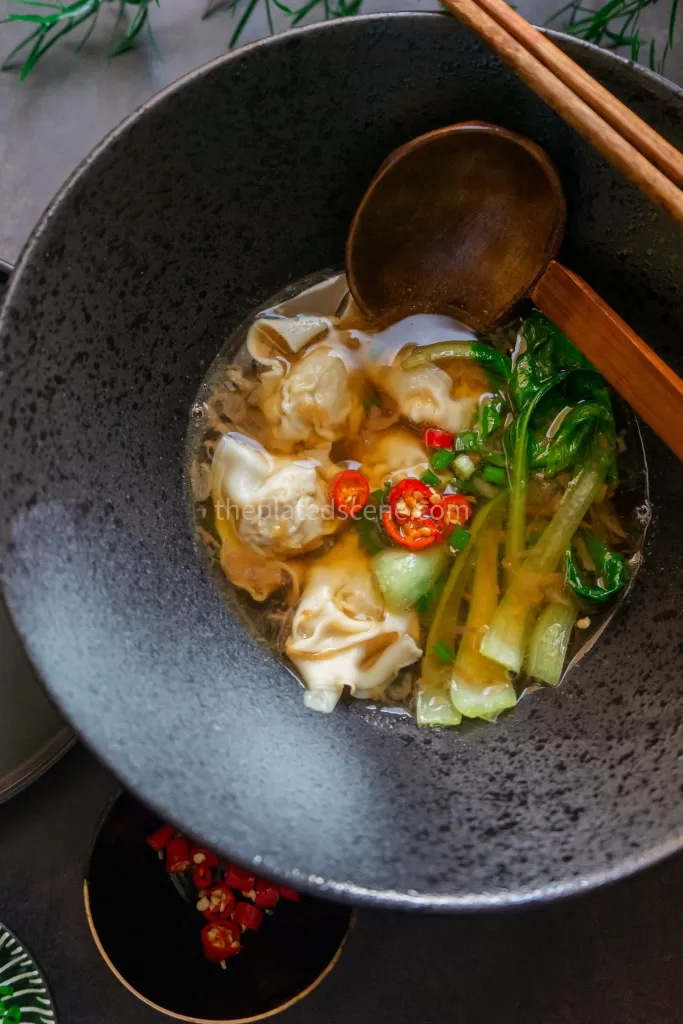
Why is this soup so special? It’s one of those meals that works for every occasion. Need something quick after a long day? One pot, minimal prep, and you’re set. Are you planning a cozy night in? The savory aroma of simmering broth will turn your kitchen into a sanctuary. Are you hosting friends? This soup is versatile enough to impress any crowd, vegan or not.
There’s also something deeply nostalgic about wonton soup. It’s a dish that feels like it belongs at the center of a table, surrounded by loved ones. Growing up, wonton soup was always the star of our family dinners. Now, I love recreating those memories with a plant-based twist that’s just as comforting and satisfying.
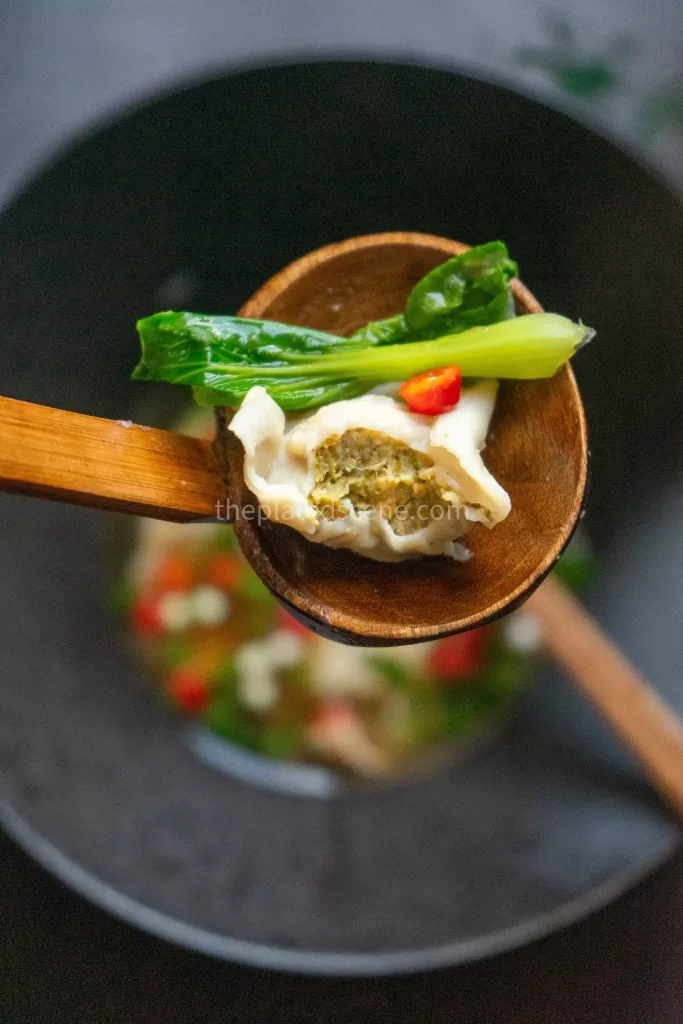
The best part? You don’t need to be a professional chef to pull this off. With a handful of ingredients and a little love, you’ll have a dish that tastes like it took hours but comes together in no time. So, grab your pot, gather your ingredients, and make some vegan wonton soup—the recipe warms you from the inside out, no matter the season.
While this recipe focuses on the broth and assembly, I also have a foolproof vegan wonton recipe that walks you through making the perfect dumplings at home.
The Cultural Significance of Wonton Soup
Wonton soup is more than just a meal—it’s a piece of culinary history. Originating in China during the Han Dynasty over 2,000 years ago, wontons were initially a winter dish, offering warmth and sustenance. The name “wonton” translates to “swallowing clouds,” reflecting the dumplings’ delicate, cloud-like appearance as they float in the broth.
Different regions in China have their own takes on wonton soup. Cantonese wontons are smaller and served in a light, clear broth, while Sichuan wontons are larger and paired with bold, spicy chili oil. As the dish spread globally, it became a favorite comfort food, adaptable to various palates and dietary needs. This vegan version honors those traditions while making the dish accessible to everyone.
Ingredients for Vegan Wonton Soup: Simple Yet Flavorful
What makes this recipe so great is how simple the ingredients are. Even with a short list, you’ll end up with a broth bursting with flavor.
Broth Base:
- Onion Powder and Garlic Powder are your shortcuts to creating a savory foundation. They mimic the sweetness and depth of sautéed onions and garlic.
- Fried Shallots: These crispy little wonders add caramelized flavor and texture. You can buy them pre-made or toast fresh ones if you’re feeling fancy.
- Black Pepper: A touch of spice to balance the flavors.
- Salt: The excellent flavor enhancer—don’t skip it!
- Soy Sauce: Your umami powerhouse. It adds depth and just the right amount of saltiness.
- Vegan Oyster Sauce: Made from mushrooms, it’s the secret ingredient for that sweet-savory combo. Here is the brand that I use.
- Sesame Sauce: This creamy, nutty sauce rounds out the broth beautifully.
- Water is the base for everything—keep it simple, or swap half for vegetable stock if you want to go extra.
Vegetables:
- Bok Choy: Adds a fresh, slightly sweet crunch.
- Spinach: Perfect for quick cooking and a boost of green.
- Napa Cabbage: Soft, tender, and a little sweet, it’s a classic addition to soups.
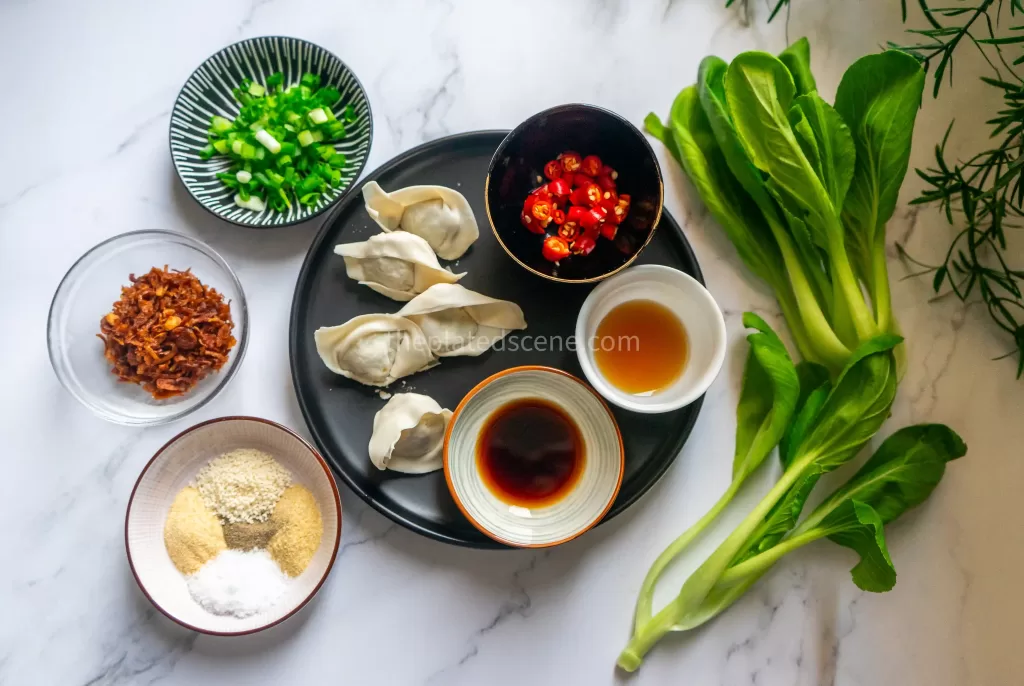
Optional Garnishes:
- Green onions
- Chili oil
- Sesame seeds
- Fried shallots (yes, again—they’re that good!)
Step-by-Step Instructions for One-Pot Vegan Wonton Soup
Making vegan wonton soup can initially feel intimidating, but with a clear plan, it’s surprisingly simple. This step-by-step guide ensures you’ll have a flavorful, comforting dish ready to serve in no time.
Step 1: Prepare the Broth Base
Start by preparing a large pot to hold the broth. Add 750ml of water and bring it to a gentle boil. Once the water is hot, begin adding your seasoning components:
- Stir in onion powder and garlic powder for a savory base.
- Add fried shallots, softening in the broth and releasing their caramelized flavor.
- Mix in black pepper and salt for seasoning.
- Pour in the soy sauce, vegan oyster sauce, and sesame sauce, providing umami and depth.
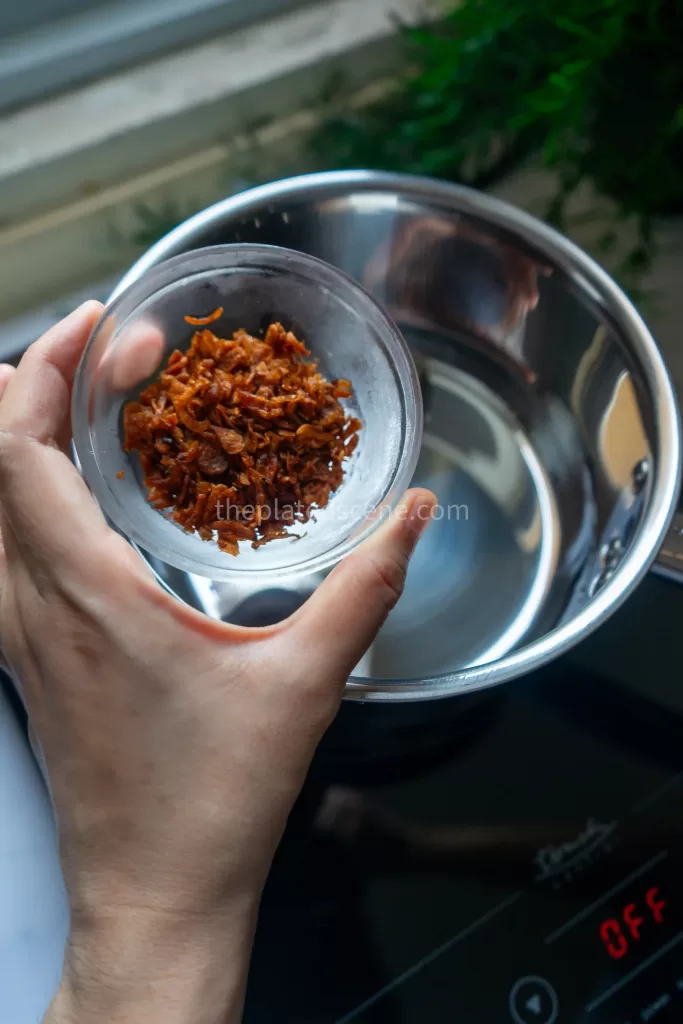
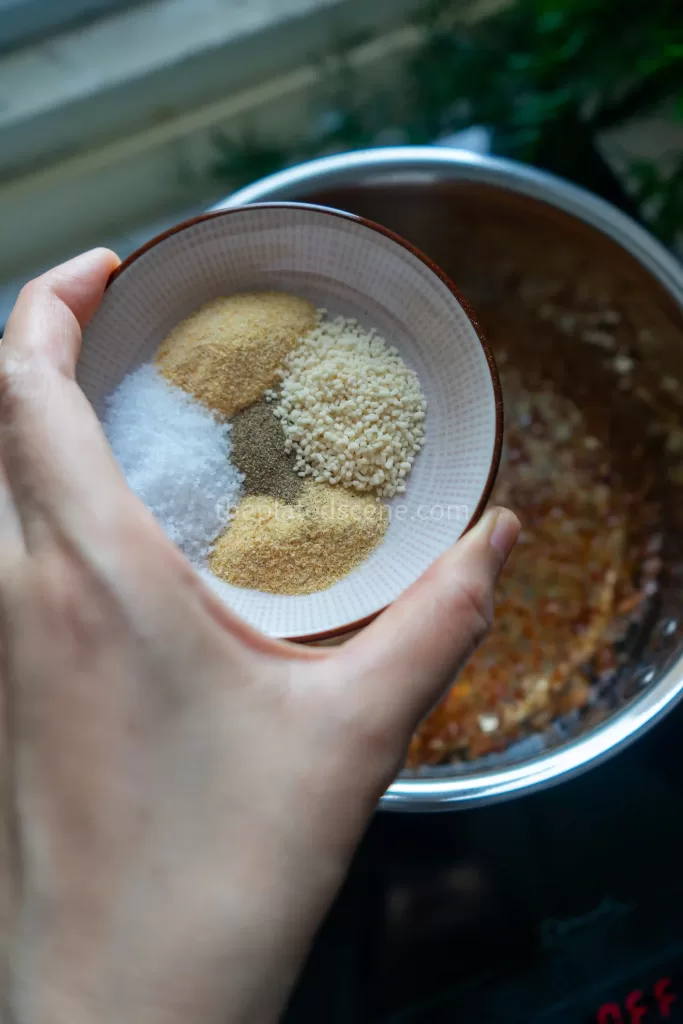
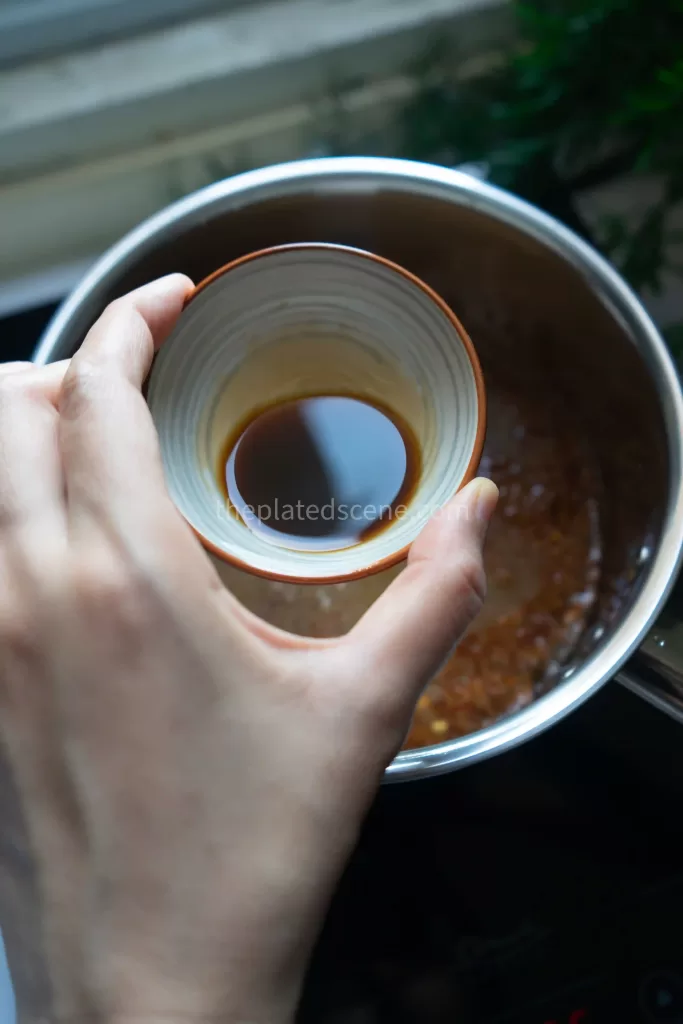
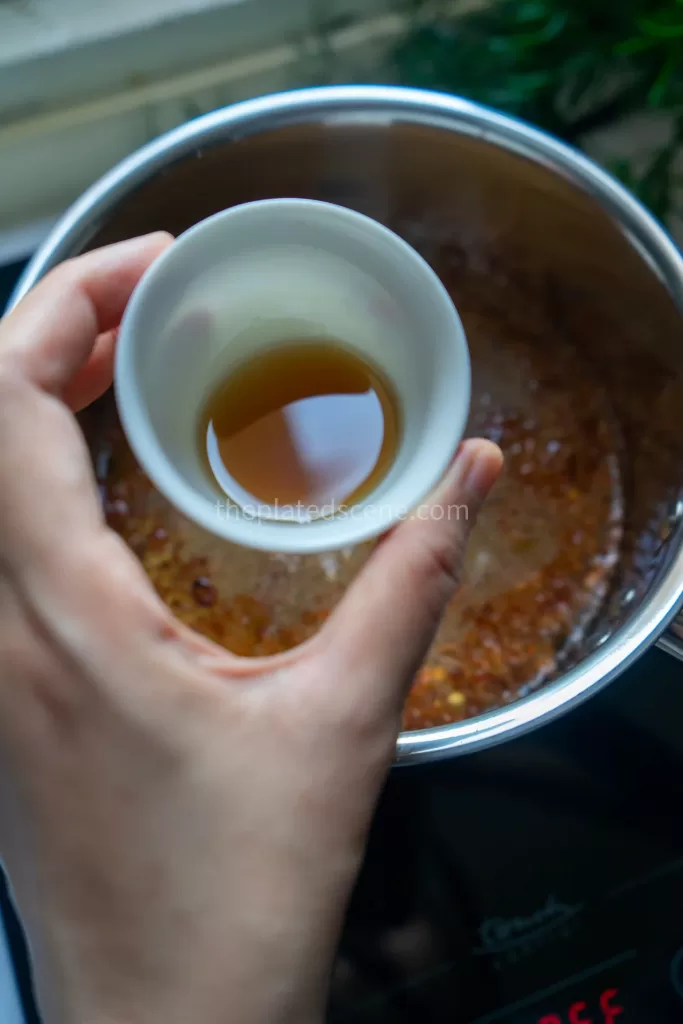
Tip: For an even richer flavor, lightly toast the fried shallots in a teaspoon of sesame oil before adding the water.
Let the broth simmer for 10-15 minutes to meld the flavors. Stir occasionally to prevent any powdery ingredients from clumping at the bottom.
Step 2: Add the Vegan Wontons
Once the broth is ready, it’s time to cook the wontons. Carefully place the wontons into the simmering broth one by one. Stir gently to ensure they don’t stick together or to the bottom of the pot.
- Cook the wontons for 3-5 minutes or until they float to the surface. Floating wontons are your signal that they’re fully cooked.
- Avoid overcrowding the pot—if you’re making a large batch, cook the wontons in two or more batches to prevent them from breaking.
Tip:
- Let frozen wontons thaw for 5-10 minutes at room temperature to prevent cracking before adding them to the broth.
- Store-bought wontons are super convenient, but if you want to try your hand at homemade, it’s easier than you think! You can find my go-to vegan wonton recipe here.
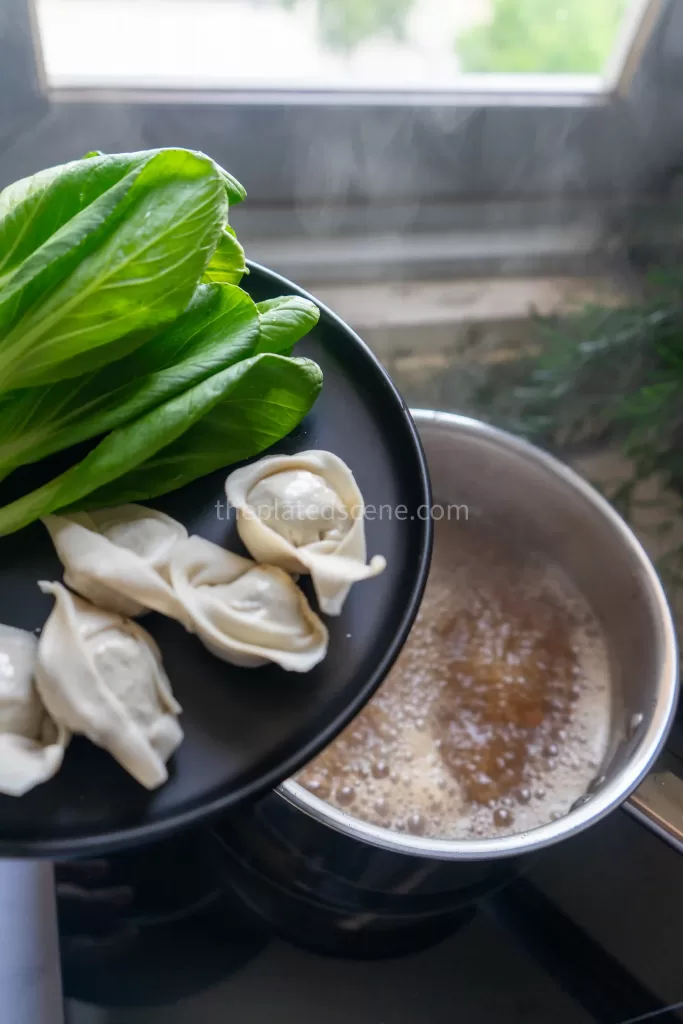
Step 3: Add the Vegetables
While the wontons cook, prepare your vegetables. Wash and chop bok choy, napa cabbage, spinach, or other greens into bite-sized pieces.
Add the vegetables directly into the broth with the wontons. If you’re using:
- Leafy greens (like spinach or bok choy): Add them in the last 1-2 minutes of cooking as they wilt quickly.
- Napa cabbage: Allow 3-4 minutes for it to soften but retain a slight crunch.
Stir everything gently to combine, ensuring the vegetables are evenly distributed.
Step 4: Taste and Adjust the Broth
Once the wontons and vegetables are cooked, it’s time to finalize the broth. Taste it and adjust as needed:
- If the broth is too salty, add a splash of water to dilute.
- Add a dash of soy sauce or a teaspoon of vegan oyster sauce for more umami.
- If you like a sweet touch, a small sugar pinch can balance out the flavors.
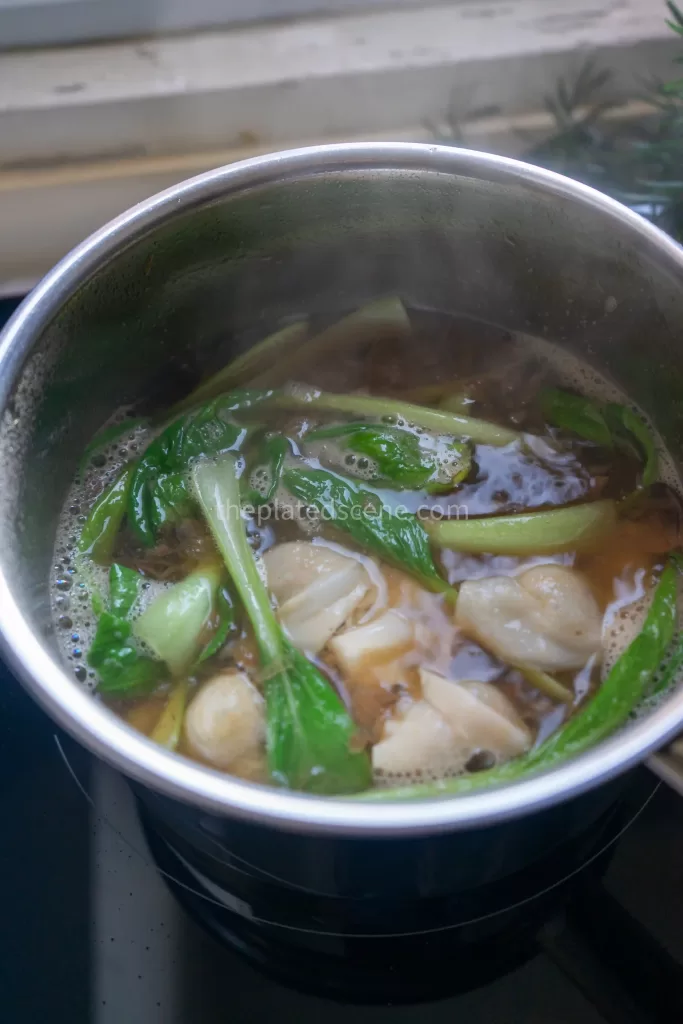
Tip: If you add chili oil or lime juice, wait until the soup is served to let each person customize their bowl.
Step 5: Serve and Garnish Your Vegan Wonton Soup
Turn off the heat and prepare your serving bowls. Divide the wontons evenly among the bowls, followed by the vegetables. Ladle the hot broth over everything, ensuring each bowl has a good balance of liquid and toppings.
Garnish your soup with:
- Chopped green onions for freshness
- Crispy fried shallots for texture
- A drizzle of sesame oil or chili oil for an extra layer of flavor
Serve immediately while the soup is piping hot. Enjoy!
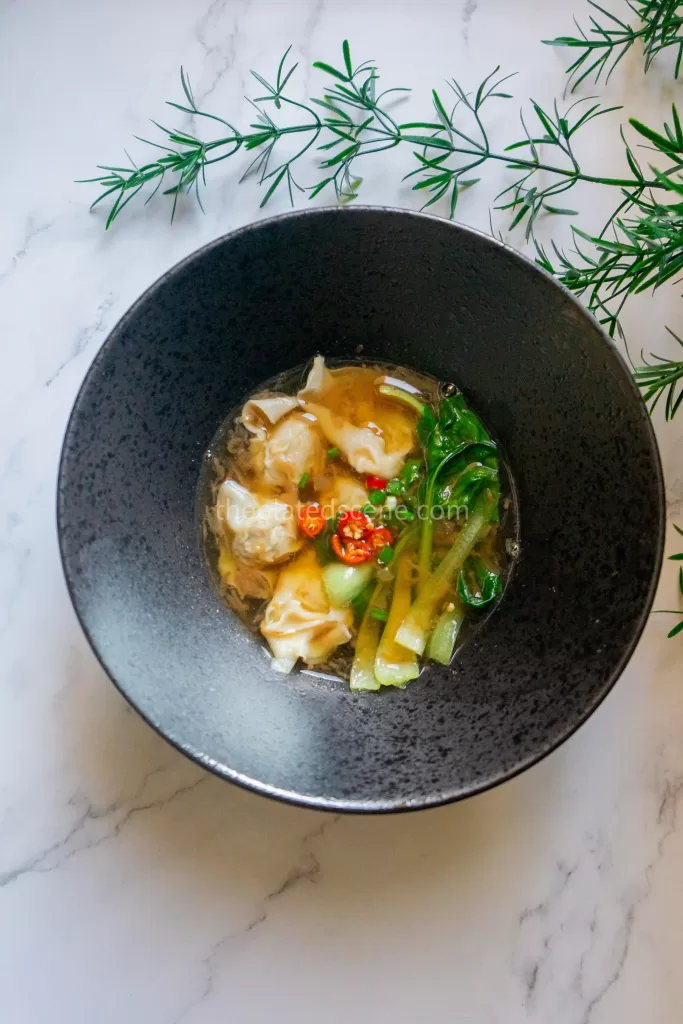
Troubleshooting Common Issues when Making Vegan Wonton Soup
Even with a straightforward recipe, a few hiccups can happen. Here’s how to solve the most common challenges when making vegan wonton soup:
1. Wontons Falling Apart in the Broth
- Problem: The wontons split open, spilling their filling into the broth.
- Causes: This could be due to overcooking, weak seals, or overly stuffed wontons.
- Solution:
- Seal the edges tightly when folding the wontons. Wet the edges with water or plant-based milk to create a stronger bond.
- Avoid overstuffing the wontons. A teaspoon of filling is enough for most wrappers.
- Monitor cooking time closely. Wontons only need 3-5 minutes to cook; leaving them in longer increases the risk of tearing.
2. Bland Broth
- Problem: The broth lacks flavor, tasting flat or watery.
- Causes: Insufficient seasoning or not letting the broth simmer long enough.
- Solution:
- Add more soy sauce for saltiness and depth.
- Incorporate an extra tablespoon of vegan oyster sauce for umami.
- If the flavors are too subtle, simmer the broth longer (up to 20 minutes) to intensify the aromatics.
3. Overcooked Vegetables
- Problem: The vegetables are mushy and have lost their vibrant color.
- Causes: Adding vegetables too early or boiling them at a high heat.
- Solution:
- Always add delicate vegetables, like spinach or bok choy, in the final 1-2 minutes of cooking.
- To preserve texture, keep the broth at a gentle simmer rather than a rolling boil.
4. Wontons Sticking Together
- Problem: Wontons clump together in the pot, making separating them difficult.
- Causes: Overcrowding the pot or not stirring after adding the wontons.
- Solution:
- Stir the broth gently after adding the wontons to keep them moving.
- If making a large batch, cook the wontons in smaller groups to avoid overcrowding.
5. Greasy or Heavy Broth
- Problem: The broth feels oily or overpowering.
- Causes: Overuse of oil-based ingredients like sesame oil or fried shallots.
- Solution:
- Use sesame oil sparingly, adding it as a garnish rather than to the cooking broth.
- Skim any excess oil from the surface of the broth before serving.
6. Frozen Wontons Cracking
Submerge them in lukewarm water for 1-2 minutes to soften the edges before placing them in the broth.
- Problem: Frozen wontons crack or break when added to the broth.
- Causes: The wrappers are too cold and brittle.
- Solution:
- Let frozen wontons thaw for a few minutes at room temperature before cooking.
Variations to Try
- Spicy Sichuan Wonton Soup: Add chili oil and Sichuan peppercorns for a bold, spicy twist.
- Coconut Wonton Soup: Replace half the water with coconut milk for a creamy, tropical variation.
- Miso Broth Wonton Soup: Stir in a tablespoon of miso paste for an umami boost.
- Noodle Wonton Soup: Add rice noodles or vermicelli for a more filling dish.
- Lime and Herb Twist: Add fresh lime juice and chopped cilantro for a refreshing flavor.
Vegan Wonton Soup Serving and Presentation
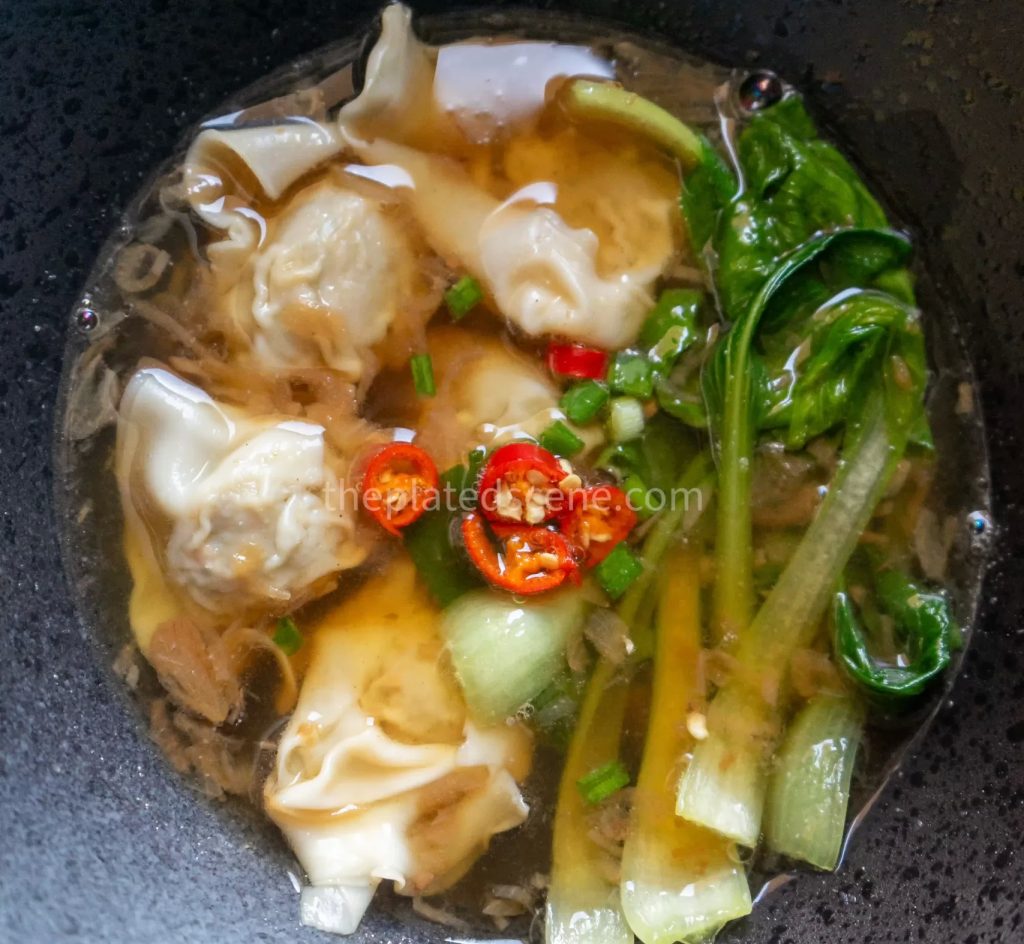
A beautifully presented bowl of soup elevates the dining experience. Here’s how to serve it like a pro:
- Layering: Place wontons first, followed by vegetables and broth.
- Garnishes: Sprinkle green onions, fried shallots, and chili oil.
- Side Dishes: Pair with steamed dumplings or vegetable spring rolls.
Sustainability Benefits
Choosing a vegan wonton soup reduces your carbon footprint and water usage. Opting for plant-based ingredients contributes to a more sustainable future while enjoying a delicious meal.
Health Benefits of Vegan Wonton Soup
Vegan wonton soup isn’t just a bowl of comfort—it’s packed with goodness that your body will love. Fresh veggies, like bok choy and spinach, are loaded with vitamins, antioxidants, and fiber to keep your digestion happy and your immune system strong (Please see the health benefits of bok choy). Meanwhile, the light, savory broth made with soy sauce, garlic, and onion powder is hydrating and soothing—perfect for a little pick-me-up. And let’s not forget the wontons! Filled with ingredients like tofu or mushrooms, they bring a satisfying dose of plant-based protein to the table.
What’s great about this soup is its striking balance: it’s nourishing, light, and versatile. Whether you are craving something wholesome after a long day or just trying to eat a little cleaner, this soup has your back. It’s a feel-good meal that delivers comfort and nutrition in every spoonful.
How to Store Vegan Wonton Soup Broth and Veggies
If you have leftover vegan wonton soup broth (without the wontons), it’s super easy to store and reheat! Here’s how to keep your broth and veggies fresh for when you’re ready to enjoy it again:
Storing the Broth and Veggies
- Let It Cool: Allow the soup to cool completely before transferring it to a storage container. This prevents condensation, which can dilute the flavors.
- Use Airtight Containers: Pour the broth and vegetables into an airtight container to keep everything fresh. If the soup has a lot of greens, strain them out and store them separately to preserve their texture.
- Refrigerate: The broth can be stored in the fridge for up to 4 days. It’s perfect for quick reheating during the week.
Freezing the Vegan Wonton Soup Broth
Want to keep your soup for longer? The broth freezes beautifully:
- Cool Completely: Always let the broth cool before freezing to avoid condensation and ice crystals.
- Portion It Out: Divide the broth into freezer-safe containers or zip-top bags. You can even use ice cube trays for smaller portions—perfect for single servings or to add extra flavor to other dishes.
- Label and Store: Label the containers with the date and freeze for up to 3 months.
Reheating Tips
Reheating your stored broth is quick and straightforward:
- On the Stovetop: Pour the soup into a pot and warm it over medium heat until it’s steaming. If the vegetables were stored separately, add them in the last minute or two to reheat gently.
- In the Microwave: Transfer the soup to a microwave-safe bowl, cover it with a plate or microwave lid, and heat in 1-minute intervals, stirring between intervals.
With these easy steps, you’ll always have a savory, nutrient-packed broth ready. Whether you’re reheating for a quick meal or using the broth as a base for other recipes, it’s the gift that keeps giving!
Conclusion: A Bowl of Comfort
This vegan wonton soup isn’t just a recipe; it’s a celebration of simplicity, culture, and compassion. Cooking the wontons and vegetables together in the broth will streamline the process while enhancing the dish’s flavors. It’s proof that comfort food can be easy, nutritious, and deeply satisfying.
Gather your ingredients, get creative with your wonton fillings, and enjoy the process of making this heartwarming dish. Each bowl reminds us that food can bring comfort, joy, and a connection to tradition.
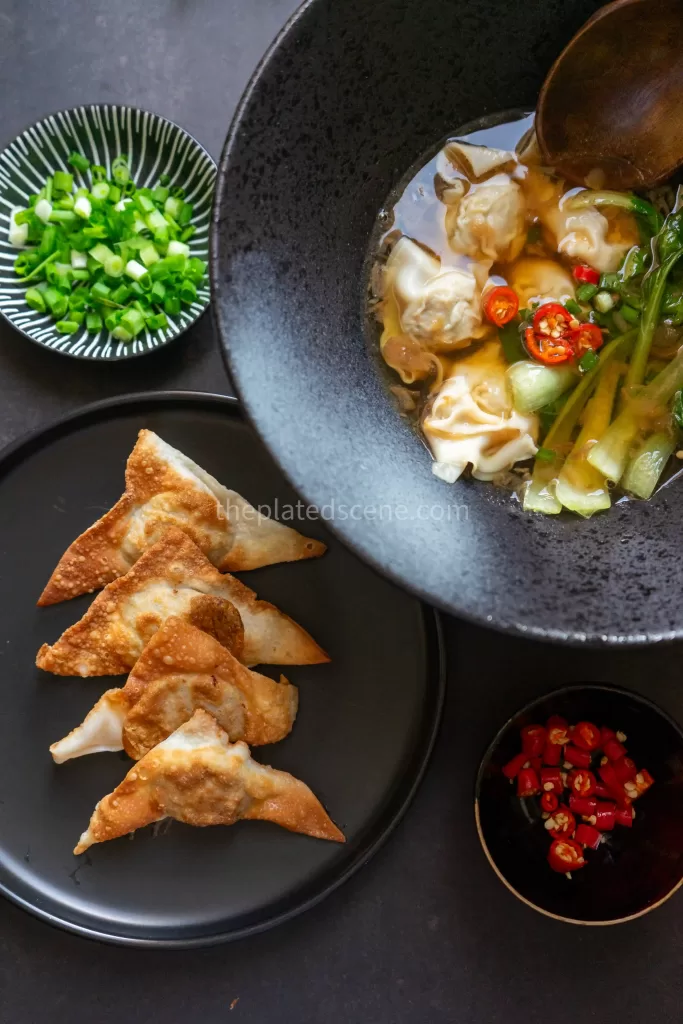
Happy cooking!

Ingredients
-
750ml water
-
1 tsp garlic powder
-
1 tsp onion powder
-
1 tsp mushroom stock
-
0.5 tsp salt
-
0.5 tsp white pepper
-
2 tbsp fried shallot
-
1 tbsp sesame oil
-
1 tbsp soy sauce
Instructions
Step 1: Prepare the Broth Base
Start by preparing a large pot to hold the broth. Add 8 cups of water and bring it to a gentle boil. Once the water is hot, begin adding your seasoning components:
- Stir in onion powder and garlic powder for a savory base.
- Add fried shallots, softening in the broth and releasing their caramelized flavor.
- Mix in black pepper and salt for seasoning.
- Pour in the soy sauce, vegan oyster sauce, and sesame sauce, providing umami and depth.
Tip: For an even richer flavor, lightly toast the fried shallots in a teaspoon of sesame oil before adding the water.
Let the broth simmer for 10-15 minutes to meld the flavors. Stir occasionally to prevent any powdery ingredients from clumping at the bottom.
Step 2: Add the Vegan Wontons
Once the broth is ready, it’s time to cook the wontons. Carefully place the wontons into the simmering broth one by one. Stir gently to ensure they don’t stick together or to the bottom of the pot.
- Cook the wontons for 3-5 minutes or until they float to the surface. Floating wontons are your signal that they’re fully cooked.
- Avoid overcrowding the pot—if you’re making a large batch, cook the wontons in two or more batches to prevent them from breaking.
Tip:
- To prevent cracking, let frozen wontons thaw for 5-10 minutes at room temperature before adding them to the broth.
- Store-bought wontons are super convenient, but if you want to try your hand at homemade, it’s easier than you think! You can find my go-to vegan wonton recipe here.
Step 3: Add the Vegetables
While the wontons cook, prepare your vegetables. Wash and chop bok choy, napa cabbage, spinach, or other greens into bite-sized pieces.
Add the vegetables directly into the broth with the wontons. If you’re using:
- Leafy greens (like spinach or bok choy): Add them in the last 1-2 minutes of cooking as they wilt quickly.
- Napa cabbage: Allow 3-4 minutes for it to soften but retain a slight crunch.
Stir everything gently to combine, ensuring the vegetables are evenly distributed.
Step 4: Taste and Adjust the Broth
Once the wontons and vegetables are cooked, it’s time to finalize the broth. Taste it and adjust as needed:
- If the broth is too salty, add a splash of water to dilute.
- Add a dash of soy sauce or a teaspoon of vegan oyster sauce for more umami.
- If you like a sweet touch, a small sugar pinch can balance out the flavors.
Step 5: Serve and Garnish Your Vegan Wonton Soup
Turn off the heat and prepare your serving bowls. Divide the wontons evenly among the bowls, followed by the vegetables. Ladle the hot broth over everything, ensuring each bowl has a good balance of liquid and toppings.
Garnish your soup with:
- Chopped green onions for freshness
- Crispy fried shallots for texture
- A drizzle of sesame oil or chili oil for an extra layer of flavor
Serve immediately while the soup is piping hot. Enjoy!

